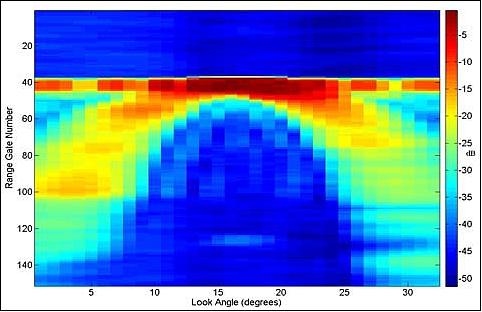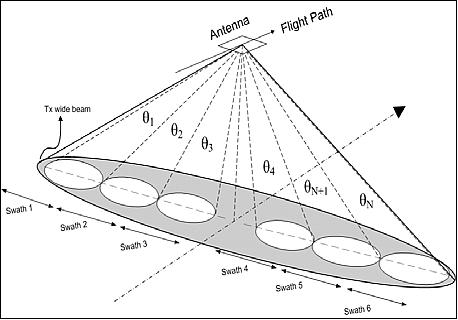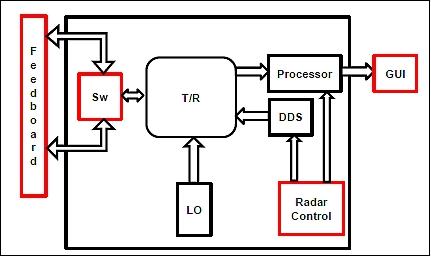DBSAR (Digital Beamforming Synthetic Aperture Radar)
Airborne Sensors
DBSAR (Digital Beamforming Synthetic Aperture Radar)
DBSAR is an airborne L-band radar system, developed at NASA/GSFC (Goddard Space Flight Center) for the introduction and implementation of digital beamforming radar techniques. The instrument assembly combines state-of-the-art radar technologies, FPGA-based onboard processing, and advances in signal processing techniques in order to enable new remote sensing capabilities applicable to Earth science and planetary exploration applications.
DBSAR's reconfigurable architecture allows the implementation of several radar operational modes using a single nadir looking antenna. The operational modes include SAR (Synthetic Aperture Radar), scatterometer and altimeter. Additional modes have been formulated and will be implemented in the future (e.g., Spot SAR, GNSS-R, and active/passive).
The ability to implement multimode remote sensing techniques by reconfiguring the radar provides great benefits to Earth science and planetary exploration missions. In Earth Science applications, DBSAR's higher resolution SAR imaging provides information about vegetation and forests types and extents, important in the study of carbon cycle. It also allows monitoring the dynamics of ice sheets, or snow accumulation and melt, important drivers of sea-level change and water cycle. The scatterometer mode can provide accurate estimates of ocean or land surface roughness (as well as the presence of vegetation, in the case of land) which when coupled with passive radiometric measurements can be used to retrieve ocean salinity and soil moisture, both important components of the global water and energy cycle. The altimeter mode can provide Earth surface mapping applicable to cryospheric, hydrospheric and oceanographic applications.
Overview
DBSAR evolved from early GSFC IRAD (Internal Research and Development) efforts aimed at the development of the RadSTAR, an active/passive spaceborne system concept that combined an L-band imagining scatterometer and a STAR (Synthetic Thinned-Array Radiometer) for the measurement of soil moisture and ocean salinity. Since then, DBSAR evolved to include state-of-the-art features such as reconfigurable hardware and firmware, a multi-channel data acquisition and real time processor system, reconfigurable waveform generation, and a high resolution navigation system.
DBSAR is a phased array system consisting of eight T/R (Transmit/Receive) channels connected to a micro-strip antenna. The transmit channels share a 1.26 GHz PLO (Phase-Locked Oscillator) and a pulse modulator. Each transmit channel incorporates a SSPA (Solid State Power Amplifier), as well as digital amplitude and phase controllers that enable across track beam steering. The attenuators, phase shifters, and calibration switches are digitally controlled by the radar control card (RCC) on a pulse by pulse basis. Calibration of the transmit channels is achieved by an internal calibration loop that routes the transmit signal into to the down-converter. 1) 2) 3)
Each receiver channel consists of a LNA (Low Noise Amplifier), a band pass filter, and a down-conversion unit. The channels share a noise source to monitor and calibrate amplitude and phase fluctuations on the receive chains. The down-converters share a 1.24 GHz PLO used to translate the microwave RF signals to an intermediate frequency of 20 MHz. After down-conversion the signals are routed to the data acquisition section of the processor. All the RF components exhibit phase linearity over a wide bandwidth.
The RCC (Radar Control Card), designed by ProSensing Technologies, receives the control signals from a host PC over an RS-422 cable and generates all the timing signals. The RCC includes and fan out board to connect the RCC to the T/R modules on each of the channels. Each T/R module controls an attenuator and a phase-shifter, as well as several switches. The T/R module holds a table of values containing attenuation and phase settings. At each pre-trigger, T/R module sets the attenuator and phase shifter with the current value and updates the current value with the next value.
The antenna is a corporate fed microstrip patch-array centered at 1.26 GHz with a 20 MHz bandwidth. The patch elements have a separation of one-half wavelength, and are printed on 0.32 mm thick Teflon-fiberglass substrate, as shown in Figure 1. Although only one feed is used with the present configuration, a provision was made for separate corporate feeds for vertical and horizontal polarization.

Center frequency | 1.26 Ghz (L-band) |
PRF (Pulse Repetition Frequency) | 50 Hz to 10 kHz |
Pulse width | 1 to 1000 µs |
No of transmitters | 8 |
Total output power (nominal) | 16 W |
Beam steering angles | ±45º |
Bandwidth (10 dB return loss) | 20 MHz |
Polarization | Horizontal |
Total antenna gain | > 20 dB |
3 dB beamwidth (nadir, along-track) | 13.6º |
Side lobes | Better than -18 dB |
| |
Instrument size | 1.2 m x 1 m x 0.5 m |
Power consumption | 350 W |
Mass | 106 kg |
DBSAR is a reconfigurable data acquisition and processor system capable of real-time, high-speed data processing. DBSAR uses an FPGA-based architecture to implement digitally down-conversion, in-phase and quadrature (I/Q) demodulation, and subsequent radar specific algorithms. The processor architecture was a custom design for the implementation SAR algorithms. The core of the processor board consists of an analog-to-digital (A/D) section, three Altera Stratix field programmable gate arrays (FPGAs), an ARM microcontroller, several memory devices, and an Ethernet interface, as shown in Figure 2. The processor also interfaces with a navigation board consisting of a GPS and a MEMS gyro.
The eight A/D converters are 12 bit devices with sampling rates of up to 170 Msample/s that provide 65.6 dB of dynamic range. The three Altera Stratix FPGAs are capable of high computation power and clock frequencies up to 400 MHz. The processor architecture can perform up to 66 Giga-multiply-accumulate (GMAC) operations/s. Six 72 Mbit 200 MHz SRAMs are used for signal processing and can store up to 4 million 18 bit words each. The system control and interfacing is managed by an on-board ARM microcontroller which uses a 256-Mbit SDRAM. A 1 Gbit Ethernet interface provides communications with a host PC for data transfers and house keeping. The processor board has dimensions 17 cm x 24 cm x 4 cm, and a power consumption of < 94 W.
The several modes implemented on the processor are based on digital beamforming which is a digital process that generates the far-field beam patterns at various scan angles from voltages sampled in the antenna array. This technique allows steering the received beam and controlling its beamwidth and sidelobe. DBSAR can operate in several beam forming modes, each characterized by unique strengths and weaknesses, and each applicable to different measurement scenarios.

Operational Modes
The processor has been configured to operate in scatterometer, SAR (Synthetic Aperture Radar), and altimeter modes.
1) Scatterometer mode: In this mode, the radar is capable to generate a wide beam or scan a narrow beam on transmit, and to steer the received beam on processing while controlling its beamwidth and side-lobe level. The radar can operate in tho beamforming modes, each characterized by unique strengths and weaknesses, and each applicable to different measurement scenarios. The scatterometer operational modes are as follows:
• Case 1: Simultaneous transmission and reception on all subarrays. In this mode, the beam is electronically scanned across the field of view. A sequence of focused beams is formed on transmission, with amplitude tapering and beam steering achieved by adjusting the gain and phase of the individual transmit modules. Similar amplitude and phase tapering is applied to the digitized signal to steer the received beam and control its sidelobe structure. The two-way sidelobe levels for such an array approach 50 dB, since the sidelobes are determined by the product of the transmit and receive power levels, which are around 25 dB. This mode of operation has the dual advantages that the transmitted power is highest and the beam is the narrowest of the different modes of operation.

• Case 2: Transmission on a single subarray, simultaneous reception on all subarrays. In this mode, the central subarray is energized, illuminating the entire field of view on each pulse of the radar. The signals received at all of the subarrays are sampled, then a digital beamforming algorithm is executed which forms simultaneous beams at various scan angles. For a given amplitude taper, the simultaneous illumination mode has have sidelobes which are twice that for beam steering, giving a practical sidelobe level of ~25 dB. The primary advantage of this type of beamforming is that it provides simultaneous imaging on all beams, which is advantageous in comparison to the ESTAR radiometer measurements, and that a greater number of samples are provided, thus providing the opportunity to improve SNR is some situations. The disadvantage is the lower transmitted power and the higher sidelobe levels.

The scatterometer mode was successfully flight tested in May 2006 and in January 2007 on board of the NASA P3 aircraft over the Delmarva Peninsula, VA using an earlier version of the beamforming processor. In scatterometer mode, the new processor will be able to generate 32 beams at a pulse repetition frequency as high as 10 kHz.
2) SAR mode: In this mode the radar can achieve fine resolutions over large swaths without degrading image quality as in the case of conventional SAR systems. Conventional SAR systems are inherently narrow swath because of imposed ambiguity limitations.

As shown in Figure 5, a wide beam is generated by energizing a small section of the antenna, as explained in the scatterometer mode. The transmitted beam illuminates entire field of view. DBSAR synthesizes simultaneously multiple cross-track beams using digital beamforming techniques, and processing each beam using SAR techniques, all in real-time. Each beam can be synthesized with different beam widths and side lobe levels so as to maintain constant swath widths and minimize side lobe contamination. Furthermore, the DBSAR system is able to synthesize beams on both sides of the track using a single nadir-looking antenna, thus doubling the coverage area.
The onboard real-time processing capability of DBSAR allows the implementation of data reduction techniques (e.g., data averaging or data compression), as well as to dynamically update firmware parameters (e.g., beam pointing angle or match-filter coefficients).
3) SAR altimeter mode: In this mode altimetry is performed on the nadir beam of the Scatterometer mode or SAR mode, as shown in Figure 6. The Delay/Doppler technique 4) is employed to reduce the altimeter foot print along track and provide better speckle reduction and precision than conventional altimeters. In, this mode, the onboard processing enables high data reduction, making this technique very suitable for spaceborne applications.

Legend to Figure 6: DBSAR collected altimeter data conjointly with the SAR wide beam mode data collection. A real-time onboard altimeter algorithm was implemented and tested during the flights.
DBSAR's first campaign took place in October 2008 when the system successfully collected multi-mode data over areas of scientific interest. Although DBSAR operated in single polarization, its architecture was designed with a dual-polarization antenna that could accommodate upgrades to polarimetric operation.
The radar was designed to fly on the NASA P3 aircraft. The radar mounted on the aircraft bomb-bay with the antenna pointing at nadir. The radar processor and power supplies were mounted on a rack which seats directly above in the fuselage.

Legend to Figure 7: The data was collected aboard the P3 aircraft using DBSAR's strip map mode.
DBSAR is capable in support of non-conventional DBSAR operational modes such as simultaneous left and right imaging of the ground track , and single pass interferometry.

DBSAR Upgrades in the Timeframe 2010/11
DBSAR's upgrade to polarimetric operation was accomplished in 2011 through an ESTO award aimed at enhancing DBSAR's capability as a science instrument. The polarimetric operation will provide information about the scattering mechanism of reflecting media which can be used to determine their properties and characteristics. Examples of media with polarimetric signatures to be measured with DBSAR include forests, agricultural areas, and ocean surface. These measurements are important for scientific research and play a critical role in future airborne and spaceborne radar missions. 5)
DBSAR's polarimetric upgrade was implemented using two design approaches. The first approach modified DBSAR's existing single polarization architecture to enable interleaved polarimetric operation (e.g., sequentially transmit and receive horizontal and vertical polarizations). This option did not provide a full polarimetric capability but it was low risky, low cost, made use of a proven architecture, and provided all radar polarizations in a sequential manner. The second approach developed new L-band transceiver modules that enable a full polarimetric operation (e.g., simultaneously transmit and receive orthogonal polarizations).
Center frequency | 1.26 Ghz (L-band) |
Maximum bandwidth | 20 MHz |
PRF (Pulse Repetition Frequency) | 40 Hz - 10 kHz |
Pulse width | 1-100 µs |
Polarization | HH, HV, VH, VV |
Slant rage resolution | 7.5 m |
Maximum output power | 16 W |
Accuracy | < 0.7 dB |
Beam steering angles | > ±50º |
Intermediate frequency | 20 MHz |
Antenna type | Microstrip patch array |
Antenna size | 1.2 m x 1 m |
Polarization | dual |
No of active subarrays | 8 |
Subarray gain | 12.5 dB |
The main objective of the upgrade was to enhance DBSAR's capability as a science instrument by adding polarimetric operation and thus enabling the measurement of the full radar backscattering matrix.
The two design approaches chosen for polarimetric operation required new dual polarity antenna feeds. As noted earlier, DBSAR's was originally designed with a dual-polarization antenna, however, the antenna feeds employed in the original design supported one polarization. Consequently, ten dual-polarity feedboards were developed for this purpose. Figure 3 shows the new feedboards integrated to the DBSAR array antenna (antenna is facing down), and the return-loss for one of the feedboards. Laboratory measurements showed that all feedboards had nearly identical performance.

Legend to Figure 9: The block diagram shows only one out of the eight transceivers, feedboards, and antenna subarrays.
The first approach made use of the existing single channel transceivers. The upgrade added solid state switches between the transceivers and the antenna feedboards to allow the selection of the horizontal or vertical transmit and receive operation. The radar‘s software and firmware were updated to support the polarimetric operation. Figure 4 shows several of the new switches installed on the radar transceivers.


Upon completion of the first upgrade approach, DBSAR was fully tested in the laboratory, and later calibrated at NASA/GSFC anechoic chamber in preparation for the August/September 2011 flight campaign. Figure 12 shows co-polarity (red trace) and cross-polarity (black trace) boresight antenna patters measurements. The patterns shown were electronically beamformed with a cosine taper illumination.

The second approach developed new transceivers capable of supporting a full polarization operation. This upgrade took a more robust approach in order to fully modernize and miniaturize the system. The new transceivers were designed on printed circuit boards and used surface mount miniature components, reducing the size by a factor 4 while exhibiting an RF performance similar to the original transceivers. Six transceiver units has been constructed and are currently being tested in the laboratory.
Figure 13 shows one of the 16 transceiver modules required for DBSAR's full polarimetric operation. A pair of modules makes up one DBSAR channel.

The two polarimetric upgrades carried out under this effort will provide more accurate estimates of important scientific parameters such as biomass and surface roughness.
The new fully polarimetric transceivers are currently being tested in the laboratory and will be demonstrated in 2011/2012 as the DBSAR flies future science campaigns.
References
1) Rafael F. Rincon, "Reconfigurable L-Band Radar," 5th EuRAD (European Radar Conference), Oct. 29-31, 2008, Amsterdam, The Netherlands, URL: http://ntrs.nasa.gov/archive/nasa/casi.ntrs.nasa.gov/20080037982_2008037083.pdf
2) Rafael F. Rincon, Manuel Vega, Manuel Buenfil, Alessandro Geist, Lawrence Hilliard, Paul Racette, "DBSAR's First Multimode Flight Campaign," Proceedings of EUSAR 2010, 8th European Conference on Synthetic Aperture Radar, June 7-10, 2010, Aachen, Germany
3) Rafael Rincon, Peter Hildebrand, Lawrence Hilliard, Damon Bradley, Salman Sheikh, Liko Krnan, Jared Lucey, "Real-time beamforming synthetic aperture radar," Proceedings of SPIE, 'Sensors, Systems, and Next-Generation Satellites X,' Vol. 6361, Stockholm, Sweden, Sept. 2006, doi:10.1117/12.690274
4) R. Keith Raney, "The Delay/Doppler Radar Altimeter," IEEE Transactions on Geoscience and Remote Sensing, Vol. 36, No 5, Sept. 1998, pp. 1578-1588
5) Rafael F. Rincon, Martin Perrine, Matthew McLinden, Susan Valett, "Digital Beamforming Synthetic Aperture Radar (DBSAR) Polarimetric Upgrade," ESTF 2011 (Earth Science Technology Forum 2011), Pasadena, CA, USA, June 21-23, 2011, paper URL: http://esto.nasa.gov/conferences/estf2011/papers/Rincon_ESTF2011.pdf, presentation URL: http://esto.nasa.gov/conferences/estf2011/presentations/Rincon_ESTF2011.pdf
The information compiled and edited in this article was provided by Herbert J. Kramer from his documentation of: "Observation of the Earth and Its Environment: Survey of Missions and Sensors" (Springer Verlag) as well as many other sources after the publication of the 4th edition in 2002. Comments and corrections to this article are always welcome for further updates (eoportal@symbios.space).